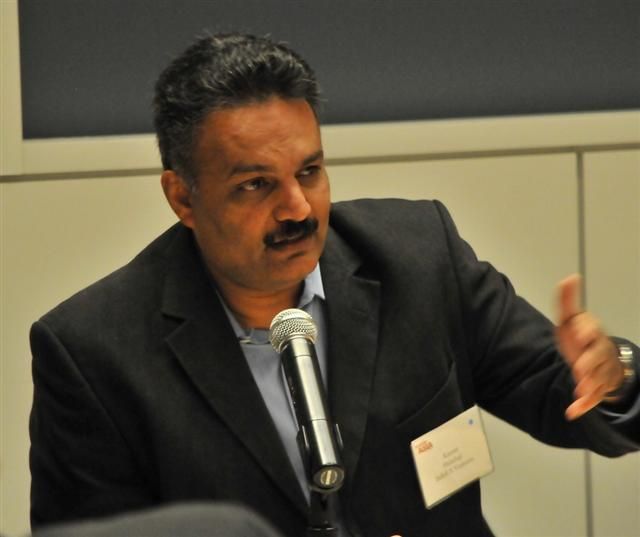2013 second half forecast - With Kumar Shiralagi, Managing Director, Kalaari Capital

We’re almost half way through 2013 and there have been quite a few deals that the Indian startup space has seen in the recent past. Some sectors, like mobile, healthcare and education are in the ascendancy while other sectors like e-commerce are consolidating. Both categories require transaction of capital and that is what has kept investors like Kumar Shiralagi of Kalaari capital busy and on their toes all this time.
This, however isn’t new for Kumar, as he brings rich venture capital experience, owing to his stint at Intel Capital which saw him add companies like NIIT, Subex Systems, Futuresoft, R-systems, IndiaInfoline to it’s portfolio. He has carried this on with Kalaari capital as well, as one third of the leadership of the $160 million fund.
In addition to this, Kumar’s experience as a corporate honcho as well as his experience as an entrepreneur is the perfect knowledge bank to rely on when trying to identify trends of this nascent Indian startup ecosystem. In a recent conversation, Kumar shared what he looked for in companies as an investor at Kalaari Capital, trends in some of the hottest sectors in the country and some inside information on what kind of companies he’s looking to fund in 2013.
Sticking to their guns
Kumar shared that Kalaari capital’s focus will remain on the kind of companies that they’ve invested in thus far. He says, “We will continue to make the kind of investments that we’ve been making in the recent past which is essentially in the 3-5 million dollar range. We will be looking for good early stage companies in the software/ IT, ITES, mobile, healthcare, education and the other usual high growth suspects.”
It has been a busy 15 to 18 months of investing for Kalaari capital and Kumar believes that the coming months will define the success of the investments - “We’ve made about 8 or 9 investments in the past 15 to 18 months. It’s been more than a year since then and this is round about the time that we will get to know about the success and failure of these companies.”
Early stage investment typically brings with it a high failure rate, but that hasn’t been the experience with most of Kalaari capital’s investments so far. Kumar says, “Of course, the failure rate is high in early stage investments, but majority of our investee companies are showing great traction. Many of our portfolio companies are profitable, some are closing subsequent round of financing and it has so far been a healthy sign for us.”
Less horizontal e-commerce, more niche players please
While many state that ecommerce industry is going through a consolidation phase of sorts, Kumar is quick to add that it is only true for one part of ecommerce. He says, “There are two kinds of e-commerce players - horizontal and vertical. There are some leaders in the horizontal phase. In this year and some years to come, they will consolidate their position in the market. However, if you look at the amount of money raised by these companies and the number of success stories that have come out of it, the road will be very rough for any company that is starting out now in the horizontal ecommerce space.”
Kumar believes that venture capital firms such as Kalaari are still interested in working with vertical ecommerce companies. He says, “I think we will see a lot more vertical ecommerce players in the coming time. Niche don’t need that much capital, and there are clear and proven exit strategies for these companies, which will keep early stage investors interested in them.”
The decline of VAS and the opportunities in APP As with ecommerce, Kumar looks at the Indian mobile space in a similar way as well. He says, “I look at the mobile market as the VAS space and the app space. In the VAS space, money is going to be a big barrier to entry for startups. There are so many complexities in working with the telcos. It’s very murky.”
On the other hand, Kumar sees great opportunity in the app and mobile services space. He says, “Given the recent growth in cell phone adoption, you can tell that there will be great consumer demand. Even today the growth only continues. The challenge in this space is figuring out a viable and scalable revenue model. If a startup has early proof, I will bet on it.”
Working with early stage companies
Kumar believes that the role of an investor on the Board of a startup requires a lot of involvement. He says, “When working with entrepreneurs, there are certain strong traits that they exhibit and some they are not as good at. They could be operationally very strong, or they’ could be good at fund raising and so on. As investors, we have an idea of traits that are required at various stages

of the company and we try to complement that with skill or talent acquisition.”In fact, Kumar goes a step ahead by saying, “We can take some of those responsibilities, be it in terms of hiring experienced professionals, making introductions of potential clients. Unlike a listed company, working with early stage companies require a lot of involvement from the investor. Also, we insist and help on setting and tracking metrics, whichs very important in the growth phase of a company.”
So, what will get you funded?
When asked about the kind of pitch that would quip Kumar’s interest, he says, “Given the number of emails we see every day, I’m looking for those emails that stand out of the rest. And it’s definitely not the one which gives me a 100 page document to read. The one’s who get funded usually create a gradual interest. Don’t give too much in the first interaction; a two page summary is more than enough. Give enough material to create an interest and that should lead to subsequent meetings. This gradual process will lead to better credibility. Also, be very clear about the numbers and their units. For example, as trivial as it is saying that you making one million this year isn’t going to make it easy for us. some do not even mention if it is dollars or INRs!.”
Kumar also shared some of the limitations that Kalaari as a fund would have, when it came to funding a company. He says, “There are certain boundaries. We are ideally looking to make 3 -5 million dollar investments in companies that are showing some traction. We don’t fund idea stage companies.” Kumar further added that they also take into account the more obvious things, like the product, business model, barriers to entry of the market and it’s uniqueness. It is important for entrpreuners to learn a bit about the investors before they approach them.
Kalaari capital places a lot of importance to the team of the company they are looking to invest in. Kumar says, “The team running the company is of utmost importance to us. We are looking for good entrepreneurs, whom we will enjoy working with. Their ethical values and their thought process will be thoroughly scrutinized. At the end of the day, we are going to work with these guys and we will look to see if we’re compatible in that way.”
Lastly, Kumar believes that entrepreneurs need to be articulate - “Entrepreneurs need to have a great sense of clarity on what they’re trying to do. I often tell them ‘write down what you want to do on a piece of paper and see how cohesive it is’. This will help you articulate your story and you will be able to sell it and get other people excited about the business.”
Re-published from the Kalaari Blog











